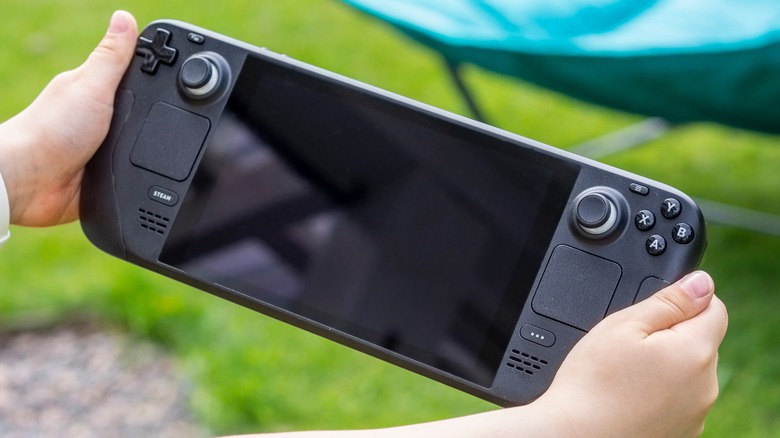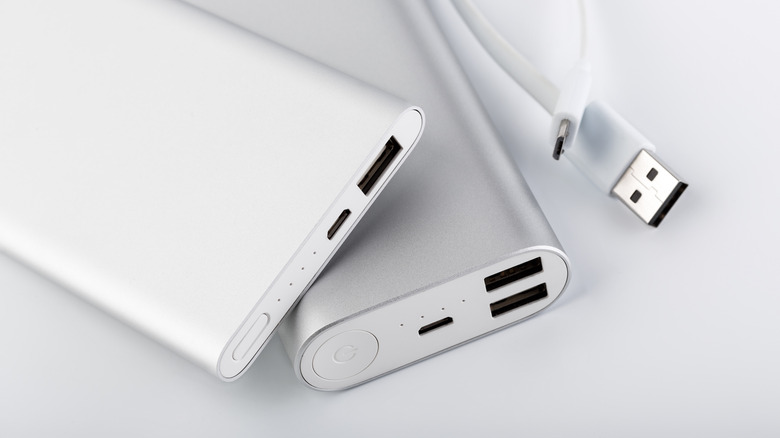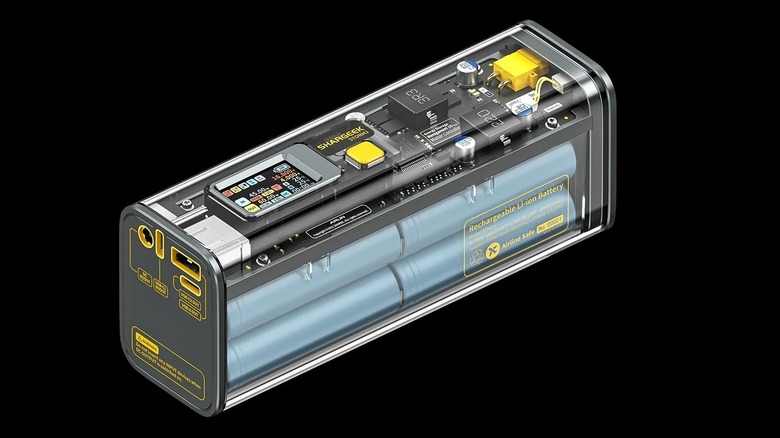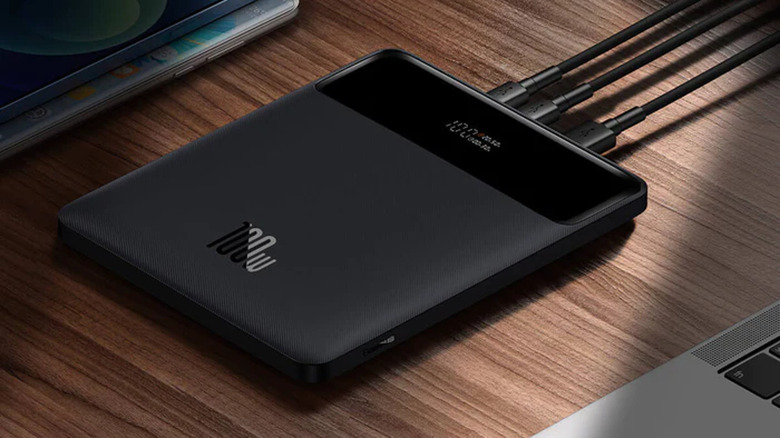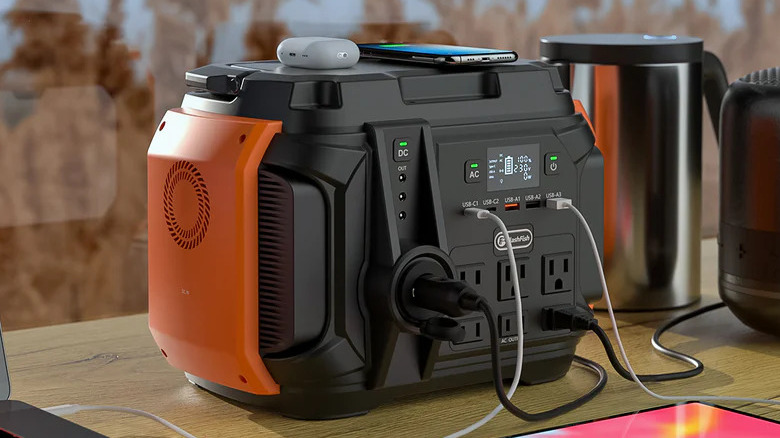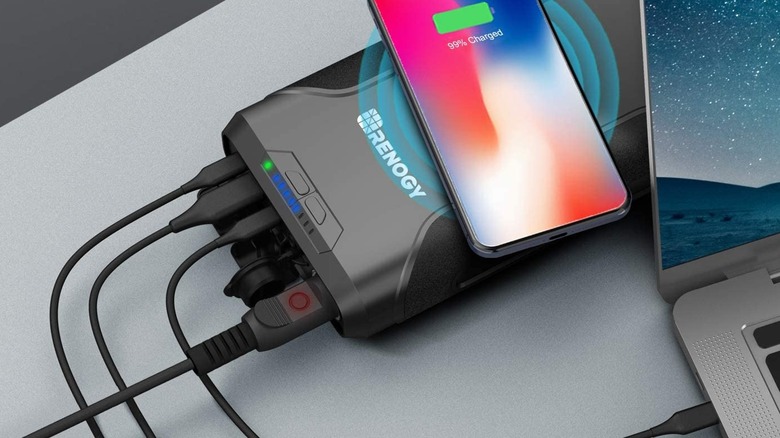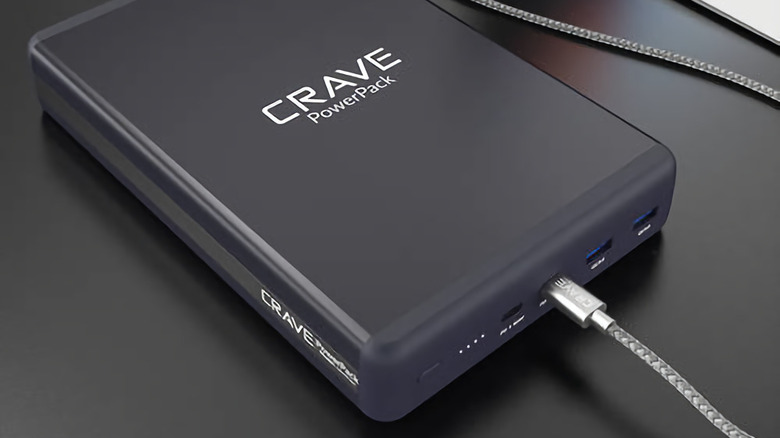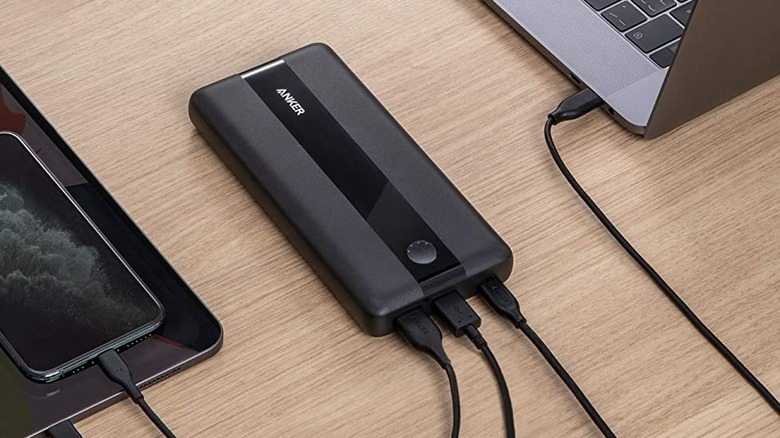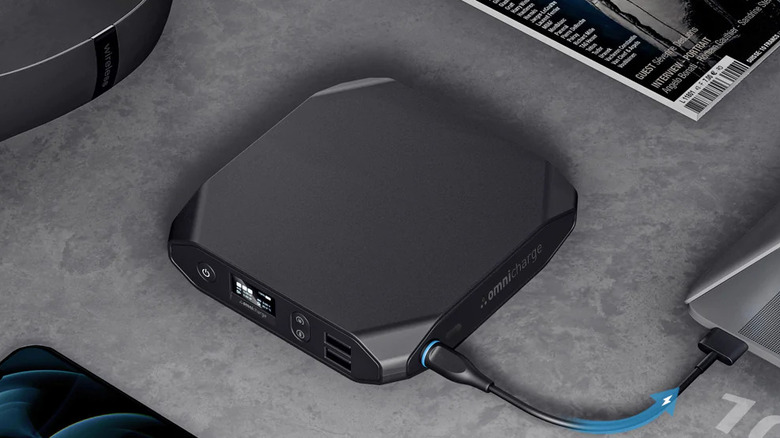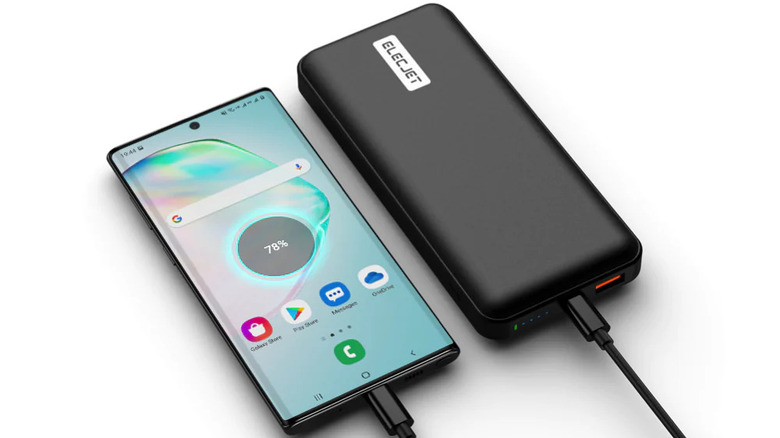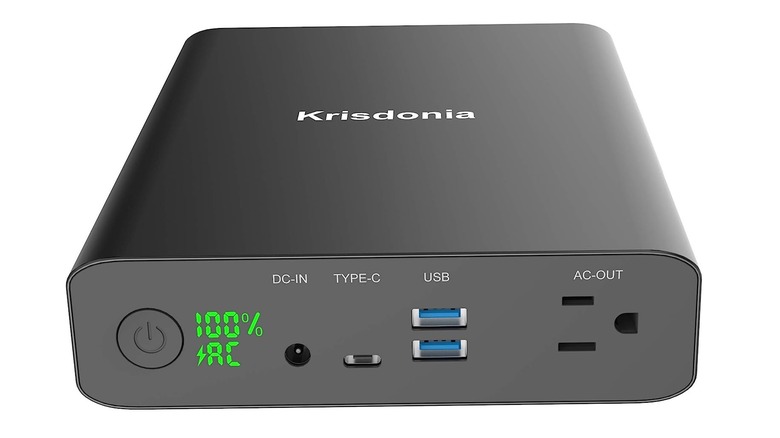9 Power Banks For Steam Deck That Will Keep You Gaming On The Go
We may receive a commission on purchases made from links.
Video games are a special kind of magic. They provide entertainment and escape in equal measure, while also giving us something to talk about with friends. More importantly, they provide a narrative medium that isn't wholly passive. Unlike reading books and movies, which move you through a story on guide rails, video games put you in the driver's seat (sometimes literally) and give you a little more freedom to explore and navigate a story according to your whims.
When Nintendo's Game Boy hit store shelves in 1989, it brought the idea of gaming on the go to the masses. Over the last few decades, Nintendo has continued to dominate the handheld gaming space, in large part thanks to its comparably affordable equipment and family-friendly titles. That's great if you're a Mario aficionado, but it leaves those of us who prefer PC gaming twisting in the wind. At least, until the release of the Steam Deck.
The Steam Deck is essentially a gaming laptop wrapped in a handheld gaming shell. It is capable of running just about anything you might usually play on a PC, with the added convenience of being untethered. It comes with a 40-watt-hour battery, allowing for between two and 10 hours of gameplay, depending on how resource-intensive your chosen game is. If you're hoping to play all of the games you love, without interruption, while you're away from home, you're probably going to need an external power bank.
Things to consider
Not all power banks are created equally and some of them don't have the oomph to power something like a Steam Deck. The last thing you want is to drop money on a battery pack only to find out it can't handle the job you need it for. The most important considerations are the amount of juice your power bank can hold, and the rate at which it can pump that juice to your Steam Deck.
Portable chargers typically list their capacity in milliamp hours, not watt-hours, which means we'll have to convert, something which is relatively easy to do as long as you know the amperage and voltage you're working with. The Steam Deck's 40 watt hours translate to 5,313 milliamp hours (mAh) and it uses a 45-watt USB-C power supply. To ensure your power bank will work with your Steam Deck, you want something that has more milliamp hours than your Deck needs and the ability to deliver at least 45 watts at a time.
You'll also want to decide if you'll need to charge your power bank and your Steam Deck at the same time. Some power banks support pass-through, allowing them to take on charge and deliver charge at the same time, while others don't. Lastly, you'll want to remember that some amount of power is lost in the conversion. You're never going to get max capacity or max power draw out of a power bank.
Shargeek Storm 2
Not only does this power bank pack a lot of punch in a relatively small package, but it looks cool to boot. Those of us who grew up with a collection of semi-transparent gadgets, which revealed the electronic guts inside our telephones, televisions, and computers, will get a kick of nostalgia from the Storm 2's transparent design.
More importantly for our purposes, it has a capacity of 25,600 mAh and adjustable output voltage. It is capable of unleashing electricity at up to 100 watts, giving you a comfortable margin over the 45 W you need for your Steam Deck. When your Storm 2 is fully charged, you should be able to get a couple of extra charges out of this power bank, potentially tripling your gaming time. With the included charging cable, two USB-C ports, a universal USB port, and an adjustable DC port, you always have options for charging all of your devices, including keeping your Steam Deck topped up while you're away from home.
At $229.00, the Shargeek Storm 2 is a sizable investment, especially for a device that doesn't cost much more than that, but making sure you can game on the go without interruptions might not be something we can put a price on.
Baseus Blade
The Baseus Blade packs a lot of power into a slim and portable package. The Blade is less than an inch thick, roughly the same size and weight as the average smartphone. The compact design makes it perfect for slipping into a pocket or jamming in the bottom of your backpack without dragging you down. Despite its compact design, it can carry up to 20,000 mAh and pump that out at up to 100 watts, more than enough to replenish your Steam Deck's coffers.
Even better, the digital display on the surface gives you real-time status updates including how much power you have left. It also gives you an estimate of how long it will take to fully charge your device. With four output ports, you can charge everything from your Steam Deck to your phone or laptop, all at the same time. Bear in mind, however, that 100 W is the maximum output the Blade is capable of. If your four devices draw more than 100 combined watts at a time, it isn't going to work. Make sure you don't overdo it.
The only thing slimmer than the Baseus Blade is the price. At $99.99, it is among the most affordable high-capacity power banks on the market.
FlashFish portable power station
Listen, this is very likely overkill if you're just trying to play "Fortnite" during your commute, but it just might be the ultimate solution for the off-the-grid gamer. The FlashFish A601 Portable Power Station can hold 540 watt-hours or 150,000 mAh. Charging even something as power-hungry as your Steam Deck will be like filling a thimble with a bathtub. Quick and easy.
Moreover, FlashFish also offers foldable solar panel accessories to keep your power station topped up even when you're far away from civilization's electrical infrastructure. With that combination, your ability to keep your Steam Deck charged is practically unlimited, as long as it isn't too cloudy. The FlashFish portable power station is bulky and it's expensive – the A601 will run you $469.99 and a solar panel will run you another hundred dollars or so depending on the version you get – but it could be the last power solution you ever have to buy.
Renogy 72,000 mAh power bank
As the name suggests, this Renology power bank packs 72,000 mAh and is designed to charge laptops. That's good news for your Steam Deck because the two devices have relatively comparable power needs and batteries. For the most part, if a power bank will work on a laptop, it will work on your Steam Deck. The built-in USB-C port can deliver up to 60 watts of power to your Steam Deck, and it has enough juice behind it to keep you charged and fighting digital baddies all day. There are, however, a couple of things to be aware of.
The first USB-C port is fast enough and powerful enough to charge your Steam Deck but the second USB-C port is not; it tops out at 27 watts, making it too weak for your Steam Deck but perfect for charging your phone. For your other devices, this power bank also offers DC in/out, as well as a cigarette lighter port and a 10-watt wireless charging pad.
The other major consideration is that this battery, despite its compact size, carries more juice than is allowed on an airplane. If you're taking your Steam Deck on a flight, you're going to need something more modest. At $159.99, this power bank from Renogy offers top-tier performance at a mid-tier price.
Crave PowerPack 2
The PowerPack earns its name by having the electrical strength of three ordinary power banks. With a capacity of 50,000 mAh, Crave's PowerPack 2 will keep you gaming into the wee hours of the night, no matter where you are. It comes standard with USB-C ports, so you don't have to fiddle with any adaptors, and is capable of delivering up to 100 watts of power to anything from your cell phone to your Steam Deck and laptop.
One of the PowerPack 2's ports unleashes the full 100 watts, a second port slows the flow to 60 watts, and two additional ports can quickly charge your phone but won't do much good for your Deck. At full charge and with minimal conversion loss, there's enough juice in this power bank to charge your Steam Deck nearly 10 times. This should be plenty of time to get back to an outlet and fill it back up, no matter how power-hungry your games library is. That functionality, however, is reflected in the price. The Crave PowerPack 2 will set you back $249.99.
Anker PowerCore III Elite
Anker is a well-respected name in the battery landscape. If you've ever bought a power bank before, there's more than a slight chance it was an Anker. The PowerCore III Elite is one of the smaller power banks on this list, but it will still get the job done. With a capacity of 19,200 mAh, this battery pack has plenty of juice to keep your Steam Deck charged, give or take a smidge.
It comes standard with a USB-C output and two additional USB outputs for charging up to three devices all at the same time. A word of caution: like other high-capacity battery packs on this list, 60 watts denotes the total output capacity of the PowerCore III Elite. If you are charging three devices at the same time, you may drop below the power output you need to reliably charge your Steam Deck.
The two additional universal USB outputs are limited to 12 watts each. Consequently, you're limited to charging your Steam Deck with one high-capacity output and up to two additional devices with a total power draw of fewer than 15 watts. Of course, topping up your phone means there are fewer milliamps left to charge your Steam Deck. With that said, it's hard to beat for $79.99.
Omni 20+
The Omni 20+ sticks out from the crowd thanks to a sleek but stylized design. Instead of the rounded rectangles we're used to, the Omni 20+ opts for a square design with shaved corners, giving the whole thing a more angular and interesting look. Its best features, however, are beneath the hood.
With a 20,000 mAh capacity and a total of 120 watts of combined output, the Omni 20+ will fill just about anything with electricity, given half a chance. In addition to a built-in USB-C output compatible with your Steam Deck, the Omni offers five different ports, including a full-sized AC plug. If it has a plug, the Omni has one way or another to connect to it — not to mention a 10-watt wireless charging pad on the surface, allowing you to charge your phone just by setting it down on top of the Omni.
With a retail price of $249.99, the Omni 20+ costs quite a bit more than other power banks with similar capacity and output, but it's got a lot of bells and whistles that make using it highly convenient. It may not last as long as other power banks, but you could plug a television into it (depending on the power draw of your model) and enjoy your stories before the battery drains. Not many battery packs can say that.
Elecjet PowerPie P20
The PowerPie P20 from Elecjet is a great entry-level option that won't break the bank. Prices vary slightly from outlet to outlet, but this power bank regularly comes in at about $70.00, which is a little easier to swallow than some of the other price points we've seen. In exchange for your monies, you'll get a power bank with 20,000 mAh and up to 45 watts of power output. You're not going to get the bells and whistles some of the other options offers, but you will get extended game time, which is what really matters.
The PowerPie P20 comes standard with USB-C and USB-A outputs packed into a package less than a pound in weight. If you want a power bank that achieves what you need without unnecessarily complicating things, the PowerPie P20 will do that. It's true that this power bank isn't going to turn any heads, but it doesn't need to. That's what your Steam Deck is for.
Krisdonia AC Outlet Portable Charger
This power bank from Krisdonia is well-rounded and that shows both in the features and the price. Getting your hands on one will set you back $269.99 plus shipping. Once it arrives at your door and you charge it up, you'll have 60,000 mAh coming at you with an output of up to 130 watts. A digital display tells you how much power you have and whether you're using alternating or direct current. There are more ports than you'll know what to do with, including a DC-in, USB-C, universal USB, and AC-out ports, ensuring you have a wide variety of options for getting power into and out of your power bank.
Speaking of power in and out, this device supports passthrough, allowing you to run power from the outlet, through your power bank, and into your Steam Deck, to charge them both at the same time. This power bank is robust enough to juice up anything from cell phones and Steam Decks to TVs and mini-fridges (emphasis on mini, don't get wild). That's not the recommended way to keep your food cold but it could save you from throwing out perishables during a power loss — or you can just use it to play video games until the end of time. Up to you.
